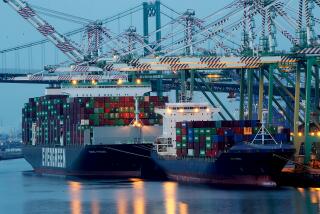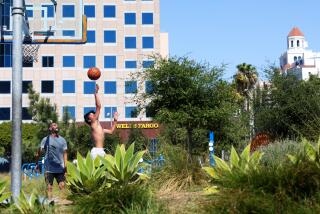Port divers plunge into their work
As the sun rises over the Port of Long Beach, two hard-hat divers step off the edge of a harbor patrol dive boat and splash into the murky waters a half-mile offshore. Their mission: to investigate the sonar blips that suggest there is a large submerged object menacing a busy shipping lane.
They disappear in a profusion of bubbles, descending 46 feet in 30 seconds to the ocean floor. A remote-controlled rover with a video camera plunges with them, so the crew can monitor their every move.
Like ground control talking to spacemen on the moon, harbor patrol Sgt. Lamar Howard leans over a microphone aboard ship and says, “Sonar shows the object 15 feet west of the boat.”
Video: Port of Long Beach divers
The divers shuffle across a field of rocks, swaying kelp and grazing sea slugs. The hiss-whoosh of their breathing issues from speakers on a ship console. A few minutes later, one of them says, “I’ve got something here. It’s an anchor, and it’s sticking up seven feet or so off the bottom.”
“We’ve got to cut it down,” Howard says. “It’s a navigational hazard.”
So began a recent workday for the only municipal port security diving unit in the nation that is certified to dive using hard hats.
The 13-member unit was initially commissioned after the 9/11 attacks as a scuba team tasked to help the port recover from a man-made or natural disaster. It added hard-hat divers after the 2003 bridge collapse in Minneapolis, which killed 13 people and blocked ship and barge traffic on the Mississippi River.
A scuba team was unable to negotiate tangles of twisted girders and crushed vehicles to reach victims of that calamity. It took Navy hard-hat divers weeks to cut up the wreckage, laboring in strong currents with limited visibility.
A similar bridge collapse in Long Beach could shut down the sprawling complex of international trade and cost the Southern California economy an estimated $1 billion a day, port officials said.
All of the unit’s divers have graduated from a commercial dive school or a military school. A few, including Howard, are harbor patrol officers, and half a dozen are being trained for that position by the Los Angeles County Sheriff’s Department.
The divers earn $50,000 to $60,000 a year. They install and repair pipelines and communications cables; inspect bridges, piers, oil rigs and shipwrecks; and respond to security and safety risks. Several members have bomb-squad training. A few have experience working underwater at nuclear reactor sites.
With video cameras on their helmets and on remote-controlled vehicles, they relay real-time images to a high-tech “war room” inside a squat white building on the Long Beach waterfront.
“What sets them apart is the range of their training and experience,” said Phil Newsum, executive director of the Assn. of Diving Contractors International, which sets industry-wide safety standards for commercial diving. “Essentially, they are certified commercial divers in law enforcement who are able to safely perform tasks beyond the range of what scuba divers can do.”
Muscled and gregarious, Howard, 40, is a master diver and welder with 21 years’ experience in the Navy and aboard oil rigs in the Gulf of Mexico and Southeast Asia. The hub of his life is the dock fronting the unit’s headquarters on the Long Beach wharf.
“The kind of diving we do is unforgiving — you can’t have an off day,” he said, toweling off on the unit’s boat after a dive. “We’re a unique regional asset, and we’re on call 24 hours a day.”
That sentiment reverberates in the unit’s headquarters and patrol boats. “My life is in my team’s hands,” said Sgt. John Bell, 35. “It’s a trust thing.”
A year ago, the unit received a certification of appreciation from the U.S. Coast Guard for the recovery and dismantling of an anchor and 14 tons of chain embedded in the ocean floor at a depth of 75 feet. The accomplishment “significantly enhanced navigation safety for the Port of Long Beach and the entire San Pedro Bay maritime community,” the certificate said.
Two weeks ago, the unit was dispatched to scrape barnacles and algae off sonar devices placed throughout the port to detect submerged moving objects. The devices can distinguish marine animals from humans based on their movements in the water.
Later this month, the unit plans to lay fiber-optic cables across a portion of the Cerritos Channel, taking care not to disturb protected eelgrass beds, which are home for a variety of marine species.
But their task on this day is more arduous. A series of two-man diving teams splashed into the port waters with underwater cutting torches.
“The torches can be dangerous,” Howard said, “because they split water molecules apart, freeing hydrogen gas, which is explosive.”
There was also nitrogen to worry about.
A diver at 46 feet is breathing air at more than twice the pressure as on the surface — meaning more than twice as many molecules of oxygen and otherwise inert nitrogen with each breath.
The largest component of air, nitrogen accumulates in blood like carbonation in a bottle of soda pop. If a diver surfaces too quickly, the blood fizzes. These bubbles can cause permanent tissue damage and sometimes death.
Nearly three hours into the job, Howard’s arms swept the scene like a football coach’s in the last quarter. “Let’s get her done, men,” he said.
The crew monitored the divers’ progress on video screens aboard ship. Sparks floated off their tools and blinked out in the current. Lobsters backed into the crevices of nearby rock piles.
It was late afternoon when Howard, torch in hand and laden with hard hat and weight belt, stepped off the boat and disappeared beneath the waves.
Twenty minutes later, his voice crackled over an onboard speaker: “I just burned all the way through. The anchor’s stem has fallen over onto the ocean floor. It’s safe to sail through here now.”
More to Read
Sign up for Essential California
The most important California stories and recommendations in your inbox every morning.
You may occasionally receive promotional content from the Los Angeles Times.











